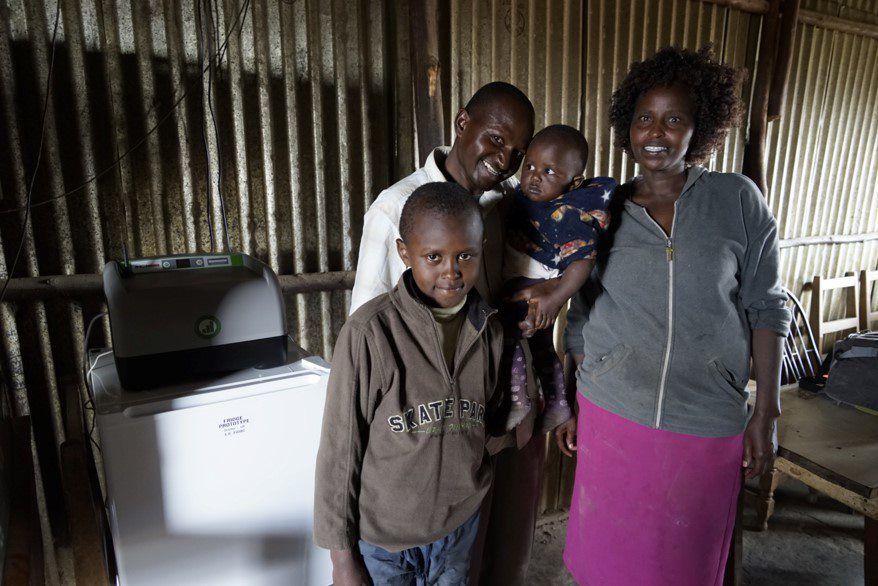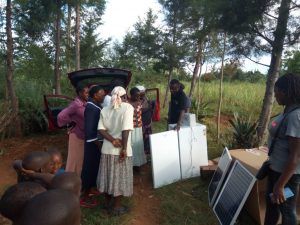It’s possible to “design things right” and yet not “design the right things”.
In a short report, M-KOPA Labs shares lessons learnt from developing its solar-powered PAYG Fridge and how its customers helped M-KOPA Labs to get the product “right”. Download the full report
Everyone wants a fridge, right?
Market surveys regularly record refrigerators in the top five appliances demanded by low-income, rural households and for impact potential[1]. It’s no surprise then that M-KOPA Labs, (the R&D arm of M-KOPA) pursued solar refrigeration as a priority R&D product.
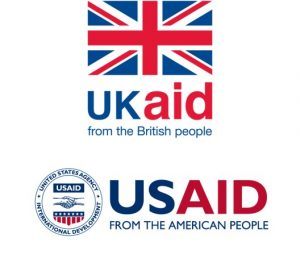 In 2016 M-KOPA labs partnered with market-leading compressor manufacturer Embraco to develop an off-grid solar fridge made affordable with M-KOPA’s PAYG financing model. Embraco showed a great focus on understanding the needs of the customers and brought cutting edge technology to the partnership. Their super-efficient compressors enabled fridges to be cooled with solar PV and chemical battery storage, rather than employing phase-change material (water that turns to ice) which adds weight, bulk, and complexity in delivery and maintenance.
In 2016 M-KOPA labs partnered with market-leading compressor manufacturer Embraco to develop an off-grid solar fridge made affordable with M-KOPA’s PAYG financing model. Embraco showed a great focus on understanding the needs of the customers and brought cutting edge technology to the partnership. Their super-efficient compressors enabled fridges to be cooled with solar PV and chemical battery storage, rather than employing phase-change material (water that turns to ice) which adds weight, bulk, and complexity in delivery and maintenance.
Given the very limited use of refrigeration amongst last-mile East African households and micro-enterprises, we were challenged to understand the benefits that would attract customers to divert scarce resources to a cooling solution, as well as measure how investment in production and assembly facilities could be recouped.
This left M-KOPA Labs locked into a situation where we could not prove the product without selling fridges, but we could not sell fridges without a considerable front-loaded investment. This posed two, critical questions for M-KOPA and Embraco:
- Can M-KOPA Labs and Embraco design a solar-powered fridge that will be readily adopted by low-income customers and unlocks immediate financial gains to support repayment?
- Can M-KOPA Labs prove the commercial viability with acceptable repayments from customers to measure scalability for Embraco?
Recognising that innovation is not possible without high up-front risk, M-KOPA Labs and Embraco embarked on a two-year R&D journey, resulting in a strong commercial partnership, a cutting-edge technology for the PAYG sector, and discovery of a new customer segment, micro-small enterprises.
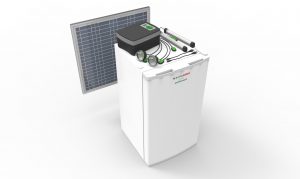 Lesson 1: Customers may not value aggregated cost-saving or time-saving benefits of a product
Lesson 1: Customers may not value aggregated cost-saving or time-saving benefits of a product
M-KOPA’s solar home system creates significant savings in the household. Solar lighting displaces expenditure for kerosene; phone charging avoids recharging fees; and TVs avoid the need for TV-viewing halls for news and entertainment. This is a very clear and value proposition for customers. However, with fridges it is more complex and unique to each customer.
Through an intensive process of market research, customer engagement, and design workshops, M-KOPA Labs identified four principal areas of time and cost savings from fridge ownership in the household:
- Bulk purchasing food on market day when wholesalers sell at lower per-unit prices than re-sellers
- Reducing the number of times a household (usually women) shops for food per week
- Enabling more efficient cooking, storage of prepared food, and reheating, reducing time and fuel spent on cooking
- Avoiding food spoilage
What we have discovered through the sales process is that households have lived without cooling for so long that they want to see others experiencing a benefit from savings before they invest their precious resources. This is perhaps smart economics given households must aggregate four types of time and cost savings before the fridge becomes cost effective. It’s also, sadly, the case that households place limited monetary value on freeing up women’s time for productive tasks other than shopping and cooking. By contrast – where customers recognise an income generating opportunity, they are much quicker to invest.
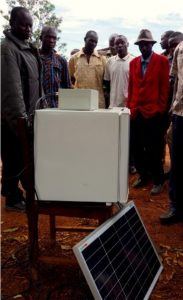 Lesson 2: right product, different customer
Lesson 2: right product, different customer
At the outset, M-KOPA Labs considered the choice between a more affordable 50-litre fridge and a more expensive 100-litre fridge.
More than half of customers consulted responded that a 50-litre fridge was enough for their household needs and, given the choice eight out of 10 people chose the smaller fridge. They also shared that “look and feel” matter and that the square, white, front-opening design is essential – despite the extra costs. Micro-small enterprise owners, however, told us that the fridge was too small and that they needed at least a 100-litre fridge to sell cold drinks. This customer input, coupled with M-KOPA’s firm understanding of the off-grid household market, led to the development a 50-litre fridge designed to optimally balance: storage required by domestic customers and suitable price point based on ability to pay.
When household customers were asked to pay for the newly developed 50-litre fridge, they declared it was “too small”. We learnt that the fridge immediately appealed more to micro-small businesses (including households wishing to start a business) than to households for domestic purposes.
As a result, M-KOPA and Embraco worked quickly and effectively to bring a 100-litre fridge to the market. Through a process of evolving the sales processes, M-KOPA also adjusted its sales effort to micro-small businesses. The new product and adjusted sales approach resulted in 300 sales in the first four months – with customers reporting their satisfaction with the product. Micro-small businesses that purchased the fridge experience significant improvements in sales and revenues, more than covering the purchase.
Lesson 3: the chicken-and-egg conundrum in bringing CAPEX intensive PAYG products to market
Regardless of the intensive engagements that we undertook to understand customers’ wants and needs, willingness and ability to pay, we only had real evidence when we asked them to put down cash for the product. This is a challenge for two businesses with similar but different requirements to implement at scale:
- Embraco required evidence to support capital expenditure on manufacturing tooling and plant; whereas
- M-KOPA wanted to experience good repayment rates across many customers (~500).
Therefore, we attempted to develop enough fridges to satisfy the needs of both parties, before we had enough evidence that customers would definitely put down cash for the product. With the benefit of hindsight, we would have developed enough fully finished products for sale to test customers purchase behaviour when presented with the finished product, and not a small number of prototypes/mock-ups, or hypothetical propositions. This is a challenging conundrum since it is very expensive to fabricate a small number of entirely new units to sell to a small number of customers – but in the future we would make that investment.
Happily, for all partners, the flexibility that Embraco showed in switching models at a very late stage has allowed us to bring to market a product that customers highly approve of and for which repayment rates are high.
So what size is the market for PAYGO solar powered fridges?
For M-KOPA Labs, the outcome of this exercise has been very positive. Sales are now doing well, customers are happy, and we have adjusted R&D processes to better identify customers’ needs and wants.
We are well on the way to proving the case for a solar powered fridge that is adopted by low-income customers and unlocks immediate financial gains to support repayment. However, the use case is initially around income generation from retail activities. The use case based upon household savings, particularly in respect of women’s time, will take longer to diffuse as a concept within communities and throughout markets. It is likely that as small retailers and households use refrigeration for income generation, they will also demonstrate the wider benefits of refrigeration to households for domestic purposes.
Repayments by customers is at or above the usual level, which we believe is linked to the positive income-generating activities linked to use of the fridge. The number of fridges sold is a small percentage of sales in more developed markets, but Embraco has clear evidence that off-grid solar fridges work well for customers.
The next stage in the process is to further increase affordability for the fridge and continue driving adoption for households as well as micro-enterprises. After all, it took 10 years for refrigerators in the US to achieve 40% market penetration![2].
We believe adoption in Kenya and Uganda can be accelerated, but customers are extremely price sensitive. Some price reductions will come from focused attention from the commercial teams of M-KOPA and Embraco. However, the opportunity also exists for well targeted risk capital to play a role in unlocking solar fridge manufacturing at scales that result in reduced prices.
The longer report on this subject captures more details of the customer-focused testing and design work that M-KOPA Labs undertook to develop the fridge with Embraco, and how the evidence collected fed into the product development process.
M-KOPA Labs would like to recognise the support provided by the UK Government and USAID through their partnership with Shell Foundation.
[1] https://ourworldindata.org/grapher/technology-adoption-by-households-in-the-united-states?time=1925..1947&country=Refrigerator
[2] https://assets.publishing.service.gov.uk/media/5bb77fc0ed915d23ad91fcb3/Market-Survey-2018.pdf

